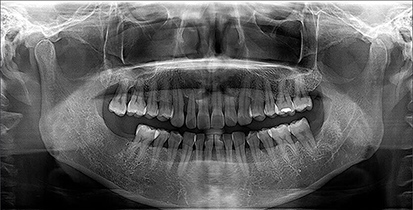
OPG X-ray
An OPG (Orthopantomagram) is a panoramic scanning dental X-ray of the upper and lower jaw. It is also sometimes called by the proprietary name Orthopantomagraph or Panorex. It shows a flattened two-dimensional view of a half-circle from ear to ear. Panoramic x-rays allow images of multiple angles to be taken to make up the composite panoramic image, where the maxilla (upper jaw) and mandible (lower jaw) are in the viewed area. The structures that are outside the viewed area are blurred. At some stage in your dental treatment, your dentist will likely take an OPG.
Advantages of OPG X-Ray Scan
 Dental OPG X RAY Scans are quick, painless, and expose the patient to a minimal amount of low-level radiation, whilst providing invaluable information to Dentists, Orthodontists and alike.
Dental OPG X RAY Scans are quick, painless, and expose the patient to a minimal amount of low-level radiation, whilst providing invaluable information to Dentists, Orthodontists and alike.
These examination use low dose x-rays, a form of radiation, to produce the required images. For dental x-rays, the dose is equivalent to about one day of background radiation.
The principal advantage of panoramic images/OPGs:
1.) Broad coverage of facial bones and teeth including the TMJ (temperomandibular joint)
2.) Low patient radiation dose
3.) Convenience of examination for the patient
4.) Ability to be used in patients who are restricted in opening their mouth
5.) Short time required for producing the image
6.) Useful visual aid in patient education and case presentation
When do you need an OPG x-ray?
When it comes to dental health, it’s best to diagnose issues at the earliest possible time to avoid potential worsening resulting in chronic problems. This is where OPG x-ray proves important as it helps dentists acquire a comprehensive understanding of a wide range of dental conditions.
OPG x-rays may be carried out to diagnose or monitor:
1.) Cavities within teeth
2.) Fractures
3.) Jaw dislocation
4.) Infection
5.) Tumours
6.) Sinuses
7.) Teeth impaction